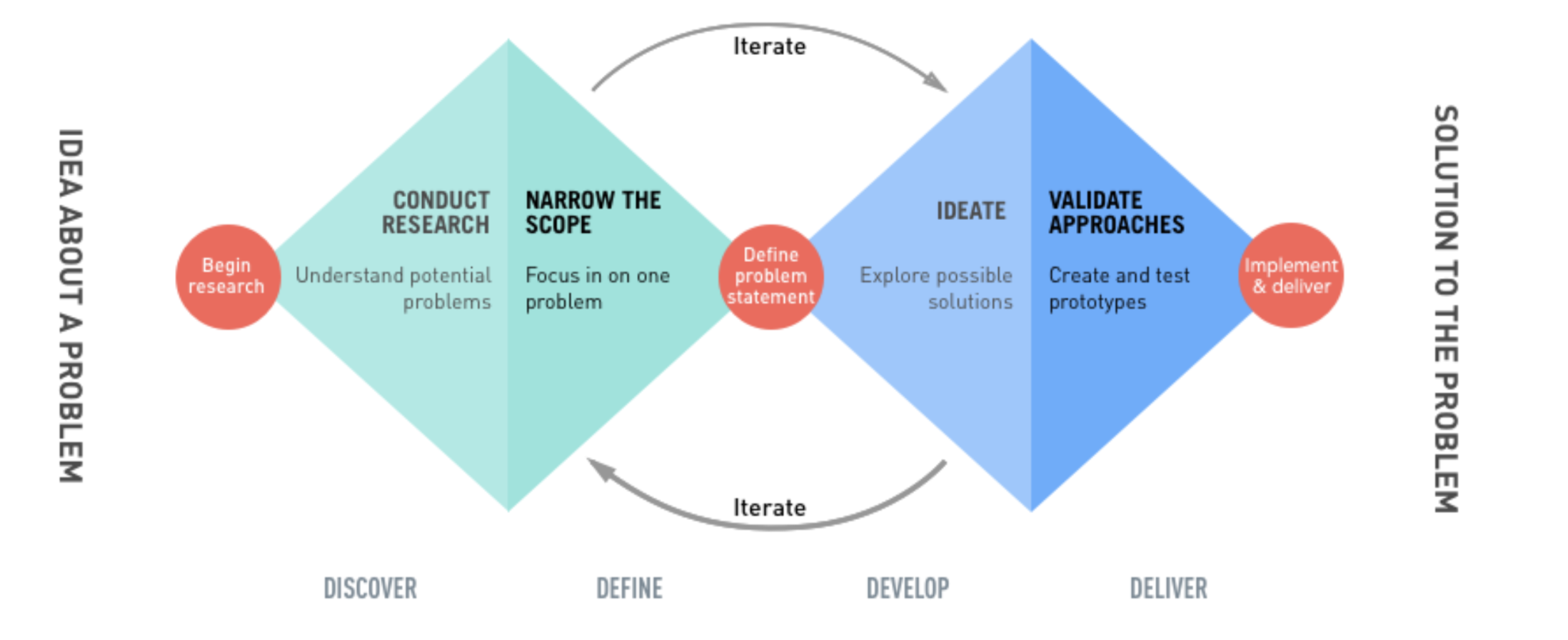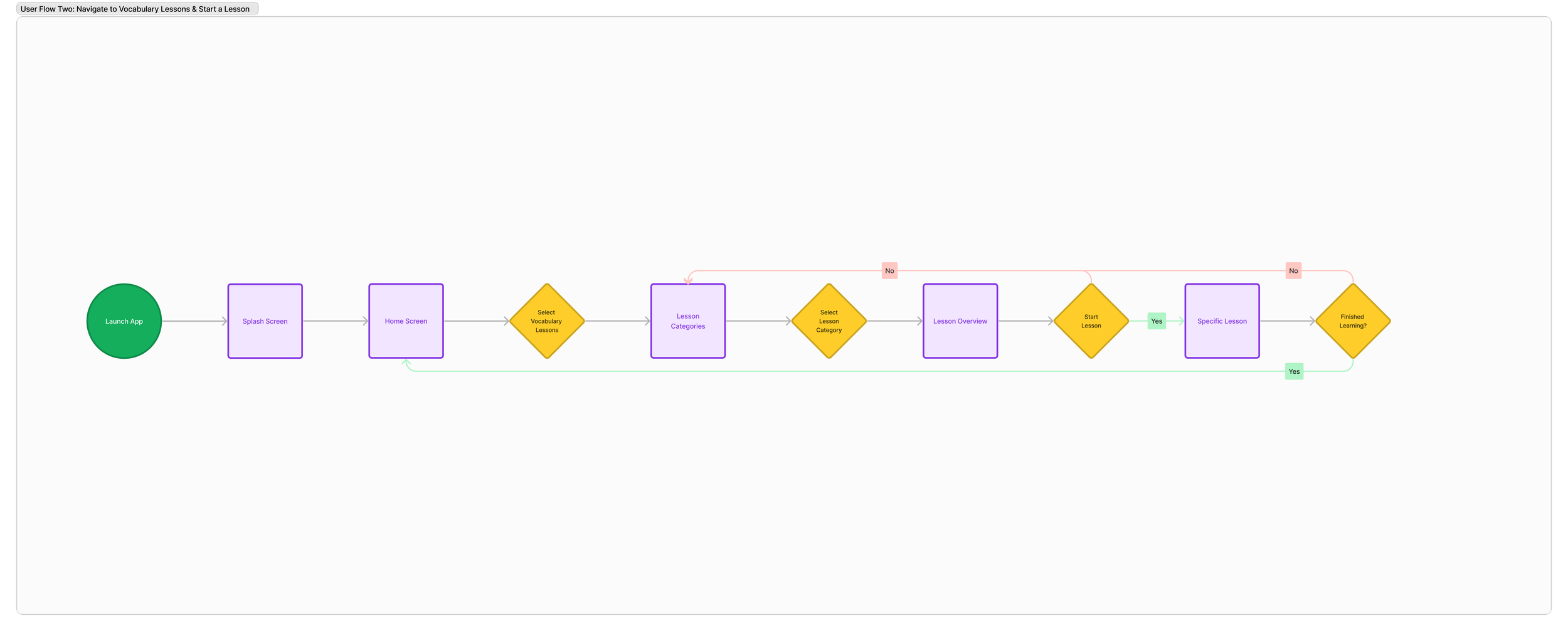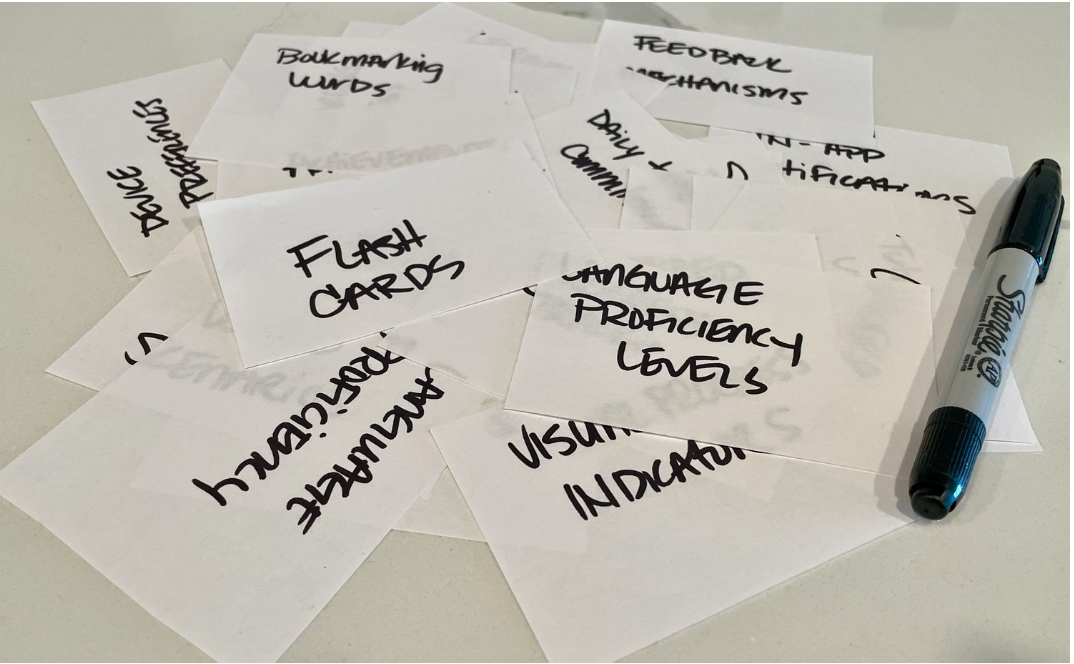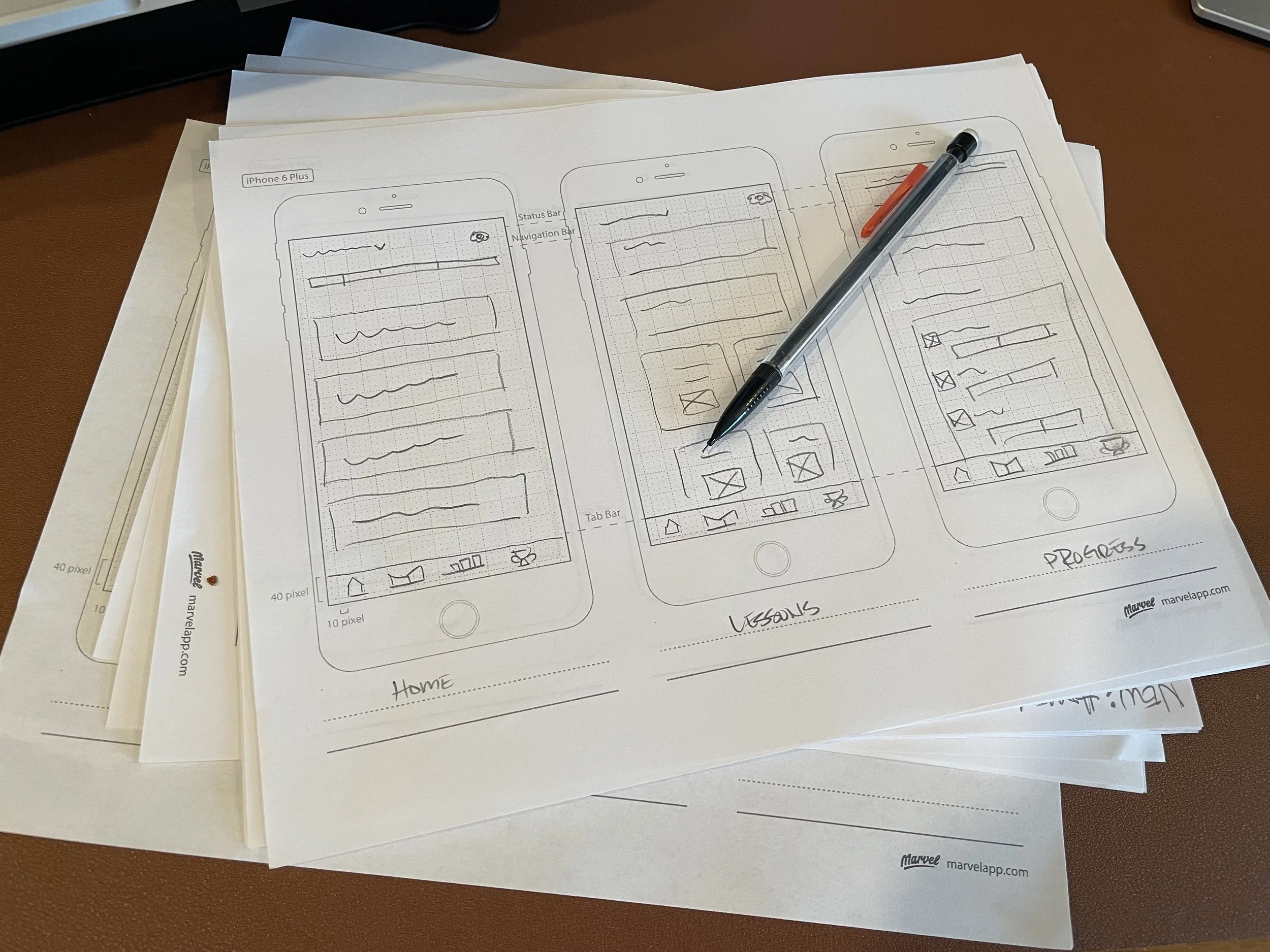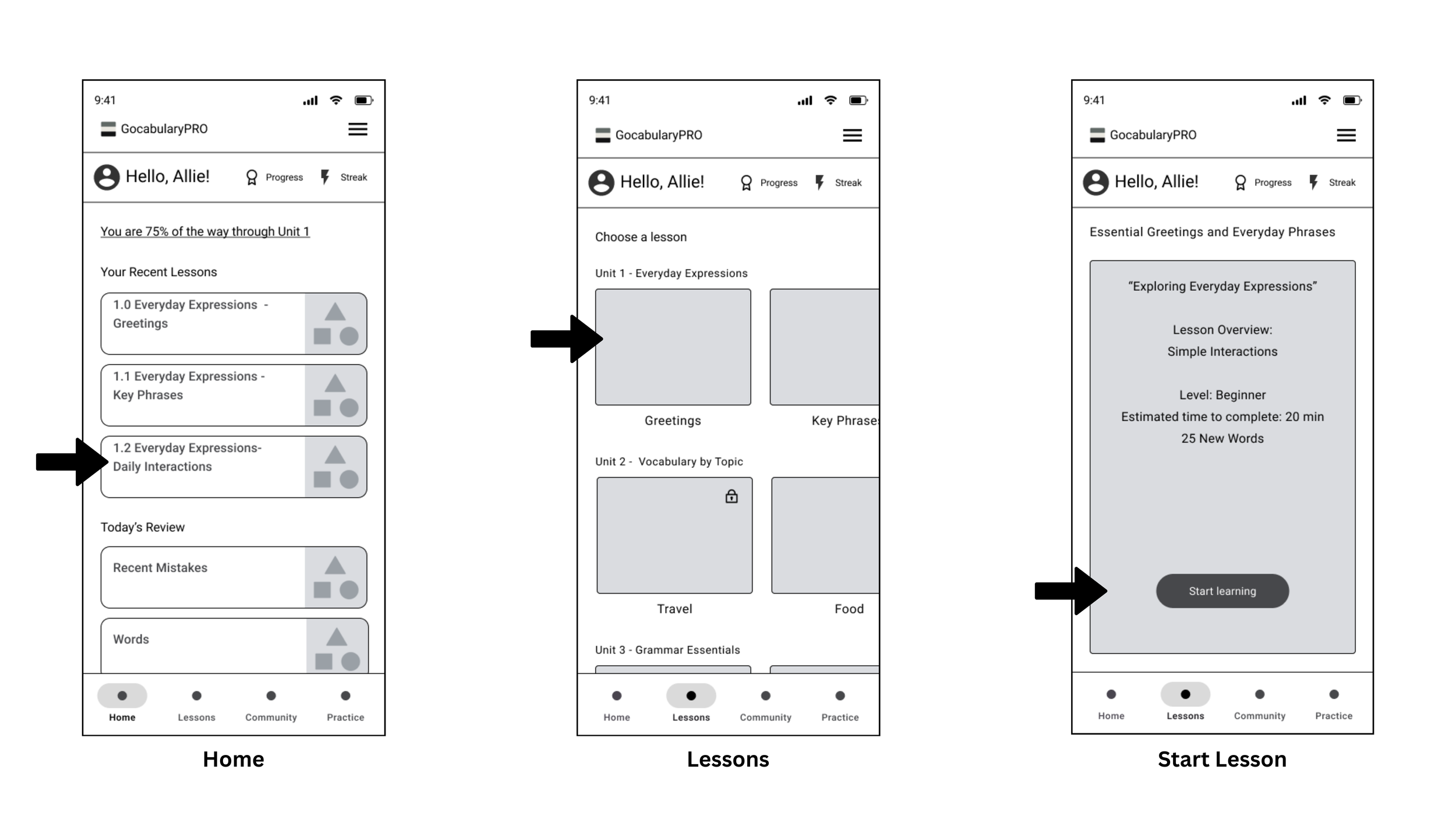GocabularyPRO is a vocabulary learning app that empowers users, whether professionals, casual learners, or language enthusiasts, to expand their vocabulary, enhance their language skills, and enjoy tailored and engaging learning experiences while on the go.
With a diverse range of features and short lessons, the app aims to make vocabulary acquisition accessible, enjoyable, and applicable to real-world contexts.
My Role
UX/UI Design | UX Research
The Client
CareerFoundry | Speculative
Timeline
April 2023 - June 2023
Tools
Figma | Sketch | Optimal Workshop | Google Surveys | Pen & Paper
The Double Diamond Design Process
Discover
Competitive Analysis
User Interviews
Empathy Mapping
Competitive Analysis
All three competitor apps effectively use gamification to enhance engagement and make learning more interactive.
User-generated content is a key feature, enabling learners to create and study their own materials.
Each app excels in different areas, such as test preparation (Magoosh) and language learning (Memrise), catering to specific user needs.
Competitive Analysis Insights
Gamification – Use progress tracking, rewards, and adaptive challenges.
User-Generated Content – Enable custom study materials and peer learning.
Unique Focus – Specialize in career-specific or industry-targeted learning.
Time Efficiency – Offer bite-sized lessons, AI recommendations, and offline access.
Personalization – Provide custom learning paths, AI feedback, and progress tracking.
Community Engagement – Support collaboration, language exchange, and anonymous participation.
Key Considerations for GocabularyPRO
User interviews were conducted both in-person and over Zoom. Three participants were interviewed over the course of two days. Interviews were between 15-20 minutes long.
User Interviews
Users preferred visual, auditory, and interactive learning methods.
Career-related goals were a strong motivator, but frustration arose from the lack of career-specific content.
Time constraints limited daily learning opportunities.
Short session usage was common across language learning apps.
Personalization and progress tracking were highly valued.
Users showed interest in community engagement for collaborative learning.
Many participants used apps to learn multiple languages.
User Interview Insights
Understand language learning habits, motivations, and preferred methods.
Identify pain points, perceived barriers, and ideal learning experiences.
Explore app selection criteria, usage preferences, and expectations.
Assess attitudes toward technology and community engagement in language learning.
Examine the career relevance of language learning.
User Interview Goals
Empathy Mapping
Define
User Persona
User Stories
Problem Statement
User Flows
After conducting user interviews, we wanted to better empathize with users of GocabularyPRO. A user persona was created of a potential user who we would be designing for. We would keep this persona in mind as we moved forward in our design.
User Persona
User stories were created to focus on defining functions and solutions from our person’s perspective.
User Stories
As Allie, I should be able to access the vocabulary app quickly and easily on my smartphone during my subway commute.
As Allie, I want to receive personalized feedback on my vocabulary learning progress, so that I can track my achievement and feels a sense of accomplishment in my language journey.
As Allie, I want to seamlessly transition between vocabulary lessons and real-world application scenarios, so that I can enhance my personal language skills and confidently use learned words in my professional communications.
Allie needs a way to seamlessly integrate vocabulary learning into her daily commute because she faces a challenge in finding time for personal enrichment amidst her hectic work schedule. We will now this to be true when we see a consistent and sustained increase in her vocabulary proficiency, as well as a positive shift in her confidence and effectiveness in workplace communication.
Problem Statement
We believe that by building a feature that tailors to quick and focused vocabulary lessons for Allie during her daily commute, we will achieve and increase in her vocabulary proficiency and a positive impact on her confidence and effectiveness in workplace communication. This feature will address Allie’s need for efficient vocabulary learning in a busy environment, leading to a measurable improvement in her language skills and professional communication abilities.
Hypothesis Statement
These user flows demonstrate how the VocabCollab app can cater to users who want to explore new words or customize their learning sessions for a more personalized and interactive experience.
User Flows
User Launches the App
User opens the app on their device
Welcome Screen
Encounter the welcome screen with a brief introduction to the apps purpose
Sign Up
Select “Sign Up” to create new account
Account Creation
Input personal details and select preferred language settings
Learning Goals Set Up
Navigate through series of screens to set language learning goals
Specify career goals, proficiency level, and preferred learning times
Onboarding Completion
Complete the onboarding process and land on the apps dashboard
User Flow One: Create an Account and Set up Learning Goals
User Flow One created using FigJam
User Flow Two: Navigate to Vocabulary Lessons & Start a Lesson
Dashboard Exploration
From the dashboard, observe progress indications and recommendations
Navigate to Lessons
Select “Vocabulary Lessons”
Browse Lesson Categories
Explore different categories of vocabulary lessons (ex. Business, Everyday words, etc.)
Select a Lesson
Choose specific lesson category and select a lesson to start
Lesson Overview
View an overview of the lesson, including the number of words, difficulty level, estimated completion time
Start Lesson
Select “Start Lesson” to initiate the vocabulary learning lesson
User Flow Two created using FigJam
Develop
Card Sorting
Wireframes
Prototyping
Testing
An open card sort was conducted to see how potential users might expect the app to be organized. This card sort was conducted using Optimal Workshop. Five participants sorted 30 cards into groups that made the most sense to them.
Card Sorting
Understand user mental models
Inform information architecture
To see how users would prioritize app features
Improve navigation
Validate or challenge assumptions
To optimize learning paths for users
Identify confusing or overlooked elements
Create a user-centric design
Ensure alignment with user expectations and goals
Card Sorting Goals
Learning activity priority
Interest in community engagement
Customization and progress
Technical and utility grouping
Interest in career-relevant features
Interest in interactive learning
Attention to notification and feedback
Consideration of learning styles
Recognition of tutorials and support
Balancing learning paths and community
Card Sorting Insights
Quick sketches were made with pencil & paper to explore different layouts and information hierarchies for the GocabularyPRO app.
Low Fidelity Wireframes
Low-fidelity sketches using Marvelapp templates.
Mid-Fidelity Wireframes were created in order to refine the layout of the app, as well as for the creation of an interactive prototype that could be presented in usability testing to test some of the user flows for the GocabularyPRO app.
Mid-Fidelity Wireframes & Prototype
User Flow One: Create an Account and Set up Learning Goals
User Flow Two: Navigate to Vocabulary Lessons & Start a Lesson
Moderated usability testing was conducted on the GocabularyPRO app to evaluate overall user experience, identify usability issues, and gather insights for improvement. This was completed over the course of 2 days. Three participants completed a series of five scenario tasks both in-person and remotely. For more details, see the links below.
Usability Testing
Evaluate user navigation to see how easily users can navigate the app to find key features such as lessons, quizzes, and progress tracking
Understand the onboarding experience and determine it’s effectiveness in helping users set up their language learning goals and preferences
Assess learning path customization by evaluating the ease at which users can customize their learning paths based on career goals, language proficiency, and their preferred learning styles
Evaluate lesson interactivity including flashcards, quizzes, and real-world scenarios, to ensure engagement
Measure progress tracking to evaluate the effectiveness of features including visual indicators, achievements, and feedback mechanisms
Identify any pain points, frustrations, or confusion points that users encounter during their interaction with the app
Goals
Navigation difficulties presented potential issues with settings structure and icon clarity
More effective onboarding or tooltips may be beneficial to some users
Participants expressed interests in more customized features and advanced settings
Overall task efficiency was good and users navigated key tasks with ease
Insights
Although there were no issues with two of the tasks associated with our two initial user flows, other usability issues were discovered for other tasks. These are displayed below.
Prototype Design Iterations
Progress
Issue: Participants were confused by the term “Proficiency Level.”
Solution: Added a “Help” icon to provide a detailed explanation of proficiency levels.Issue: Participants could find their progress but felt it lacked depth.
Solution: Enhanced analytics to display average study time, total weekly study time, and an option to set study time goals.
Home Screen
Issue: Participants struggled to locate the “Settings” and “Lessons” buttons.
Solution: Redesigned the Home page with clearer, more intuitive, and consistent UI patterns.Issue: Participants were frustrated by the lack of detailed insights and goal tracking.
Solution: Added a progress indicator to the Home screen and notifications on required lessons for the next section.Issue: Participants had difficulty finding the “Progress” section.
Solution: Introduced a more intuitive progress icon and a clearer link on the Home screen.
Practice: Flashcard Sets
Issue: Participants had difficulty locating the flashcard sets.
Solution: Added consistent UI patterns to improve navigation, with future iterations planned for tooltips or quick access buttons.Issue: Participants were frustrated by the lack of diverse content and wanted to create their own flashcards.
Solution: Introduced a feature allowing users to create custom flashcards.
Community
Issue: Participants found the “Community” section unappealing and did not see the value in community-based learning.
Solution: Added gamified elements and “Friend Suggestions” from contact lists to encourage engagement.Next Steps: Since this was not a usability error, it received less focus in this iteration. Future updates will further develop challenges, contests, and anonymous participation options.
Deliver
Revised Prototype
Usability Validation
During usability testing, there were no severe user errors in regards to the two tasks given to participants regarding the wireframes created our the two user flows, “New Word Exploration,” and “Starting a Lesson.” created initially. Cosmetic changes to these two user flows are displayed below.
Revised Prototype
User Flow One: Create an Account and Set up Learning Goals
User Flow Two: Starting a Lesson
Want to try the GocabularyPRO app?
Develop
Key Takeaways
Next Steps
Through this case study, I learned the importance of user-centered design, research-driven decisions, and iteration. I saw how navigation challenges, personalization gaps, and time constraints impact user experience and how gamification and clear UI patterns can improve engagement. The community feature reinforced the need to validate assumptions before committing to a design. Overall, this experience taught me how to balance user needs with business goals while making informed, data-backed design decisions.
Takeaways
Refine Navigation & Personalization – Improve UI consistency, streamline navigation, and enhance progress tracking to better align with user needs.
Reevaluate Community Engagement – Conduct further research on making social features more valuable, including anonymous participation and collaborative learning.
Expand Gamification & Career-Focused Learning – Enhance motivation with challenges and rewards while exploring career-specific language learning options.
Next Steps
Thank you for reviewing the GocabularyPRO case study.
Any feedback you would like to provide, is appreciated. If you would like to share or are interested in working with me, please feel free to reach out!


